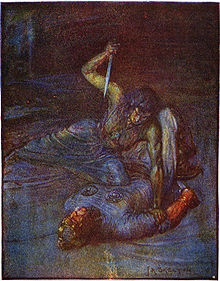The grindylow is a malignant Yorkshire water spiritType of primitive spiritual entity from the pagan past, perhaps the manifestation of a race memory, usually associated with a single place. said to lurk in stagnant pools, dragging down into the water those children who venture too close.[1] It is described as being human in shape, with long arms, long fingers, sharp little horns and green teeth. Like Jenny GreenteethWater spirit said to inhabit pools in Cheshire, Lancashire and Shropshire. If children venture too close, then she reaches out of the water and drags them in to their deaths. in Cheshire, Lancashire and Shropshire, and Peg PowlerEvil spirit of the River Tees in northeastern England, said to drag children who ventured too close the water's edge to their deaths., who inhabits the River Tees in northeastern England, the grindylow is almost certainly a nursery bogey intended to scare young children away from dangerous bodies of water. It is perhaps best known today for its appearance in the lake near Hogwarts, in J. K. Rowling’s book Harry Potter and the Goblet of Fire.[2]
The name grindylow is thought to be associated with the gigantic monster Grendel in the Anglo-Saxon epic Beowulf, whose mother tries to drag the hero to his death in her watery lair.[3]

